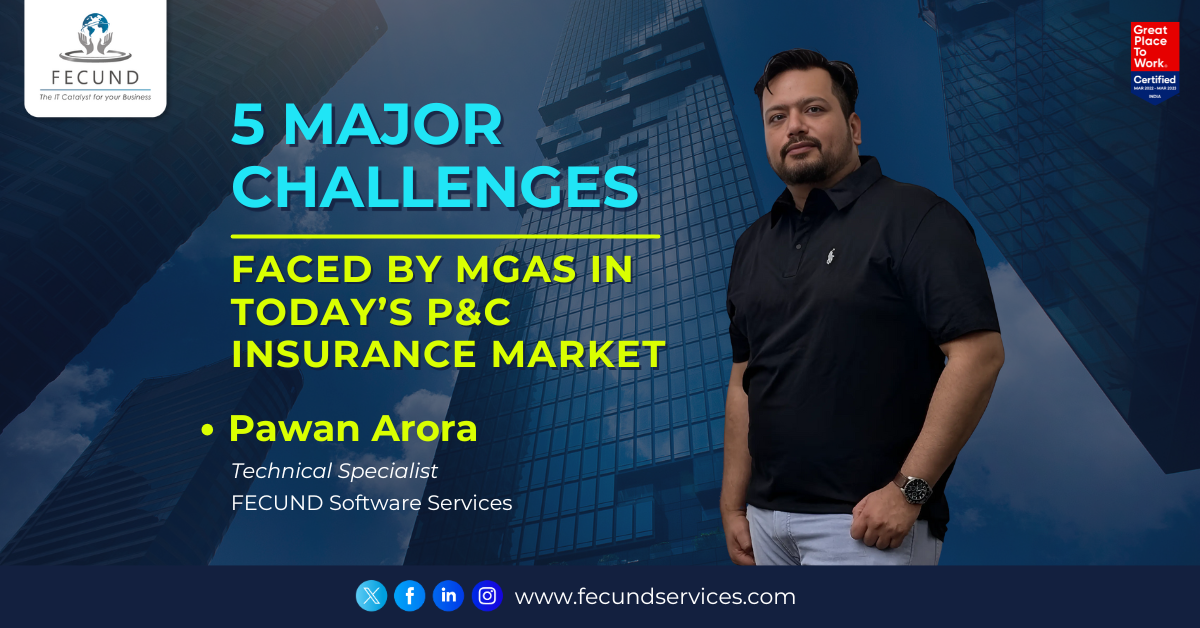
In the rapidly evolving property and casualty (P&C) insurance landscape, Managing General Agents (MGAs) are emerging as key players, especially in niche markets. Their ability to underwrite on behalf of carriers, swiftly enter new segments, and tailor products to customer needs makes them valuable in an era of customization and speed. However, they also face several challenges that could hinder their ability to deliver value and scale operations efficiently.
Let’s explore the five major challenges MGAs face—and what they can do to overcome them.
-
Balancing Growth with Underwriting Discipline
MGAs are under constant pressure to scale quickly and prove their value to carrier partners and reinsurers. This drive for aggressive expansion, while understandable, can come at the expense of disciplined underwriting. Rapid premium growth without thorough risk evaluation can lead to higher loss ratios, which in turn damage the MGA’s credibility and future opportunities with carriers.
To maintain a sustainable growth trajectory, MGAs need to integrate advanced analytics, continuous loss monitoring, and real-time portfolio management. Using machine learning tools and predictive modeling, MGAs can make data-informed decisions that protect the bottom line while expanding business responsibly.
Real-life tip: Successful MGAs are investing in dynamic pricing and granular segmentation strategies that allow for scalable growth without sacrificing risk quality.
-
Navigating Regulatory Complexity
The insurance regulatory environment is notoriously complex. MGAs operating across multiple jurisdictions must stay abreast of local compliance laws, licensing requirements, and evolving data privacy rules. Non-compliance risks include penalties, delays in approvals, and reputational harm.
Additionally, as governments introduce climate, ESG, and AI-related insurance regulations, the burden on compliance teams is growing. MGAs must be proactive in working with legal experts and adopting compliance automation platforms.
Proactive approach: Establish centralized compliance teams and leverage RegTech tools to track and manage jurisdictional updates in real time.
-
Data Integration and Technology Gaps
Many MGAs still rely on legacy systems or fragmented platforms, limiting their ability to create seamless experiences for brokers, underwriters, and clients. This technological gap restricts insight generation and operational efficiency, especially when integrating with carriers’ or reinsurers’ systems.
Modern MGAs need end-to-end policy administration systems, low-code/no-code tools for quick product launches, and APIs for seamless integration with third-party services like payment gateways, customer portals, or digital distribution platforms.
Digital priority: Embracing Insurtech collaborations or building proprietary tech stacks can help MGAs automate workflows and scale efficiently.
-
Talent Acquisition and Retention
The war for talent in insurance is intensifying. MGAs require not just underwriting talent but also data scientists, actuaries, compliance experts, and technologists. However, competing with large insurers or tech startups for this talent pool is not easy.
Moreover, the hybrid and remote work revolution means that expectations for work-life balance, culture, and digital fluency are higher than ever. MGAs must build a people-first culture and continuously invest in learning and development.
Winning the war for talent: Offer flexible work models, prioritize diversity, and create strong career paths to retain top performers.
-
Pressure for Differentiation
With digital disruption rising, MGAs can’t afford to be generic. Specialization is no longer a strategy, it’s a necessity. Whether focusing on underserved markets (e.g. Gig workers or pet insurance) or embedding insurance into third-party ecosystems (like ride-hailing platforms), MGAs need to innovate fast.
Creating hyper-personalized products using AI, machine learning, and IoT data can help deliver better experiences. Embedded insurance, parametric products, and usage-based insurance models are just a few innovations gaining traction.
Stand out or be left behind: MGAs must move from being just intermediaries to becoming digital-first, customer-centric, and innovation-driven businesses.
Conclusion: The Path Forward
MGAs are at a crossroads. The market is ripe with opportunity, but only those who embrace digitalization, invest in talent, ensure compliance, and stay customer-focused will win in the long run.
The future MGA is not just a middleman – it’s a dynamic, tech-enabled insurance brand delivering value to both carriers and consumers. Those who solve today’s challenges with vision and agility will lead tomorrow’s transformation into P&C insurance.
Check for the latest updates on our OneShield Services, feel free to contact us at info@fecundservices.com!


